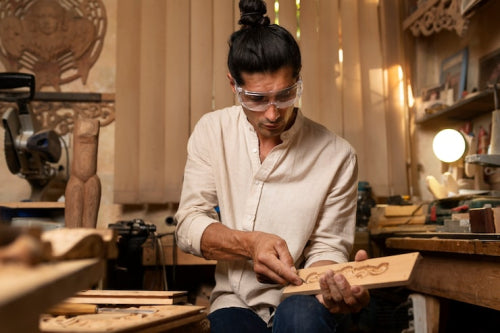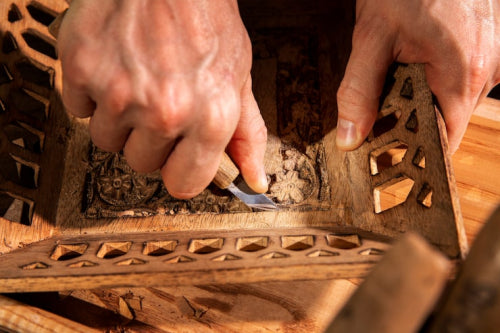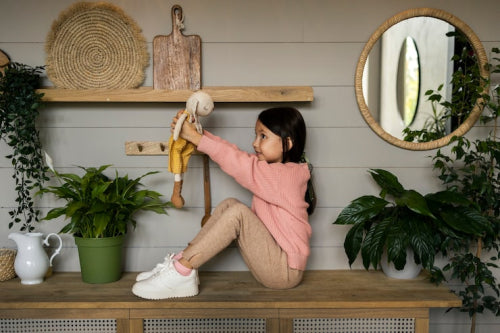Quick Listen:
In the sun-baked ateliers of Rajasthan, where the air hums with the rhythmic scrape of chisels on wood, a master artisan breathes life into a mango wood armoire. Its surfaces, etched with swirling paisley patterns passed down through generations, whisper tales of Mughal grandeur. Fast-forward to a sunlit Paris apartment, where that very armoire anchors a minimalist space, its warm tones softening the crisp lines of contemporary decor. This is the quiet revolution of Indian artisan furniture: a craft rooted in ancient traditions that's now commanding stages in the world's most discerning interiors. No longer mere curiosities for collectors, these pieces from intricately latticed screens to robust teak dining sets are redefining luxury living, one hand-hewn curve at a time.
Mass-market furniture lacks heart, filling rooms with bland, short-lived pieces. Frequent breakdowns spark frustration, as replacements erode style and sentiment. At MMC Wood Creations, Udaipur artisans shape heirloom furniture with enduring craftsmanship and cozy elegance, creating pieces that echo your identity, ensuring your home radiates warmth and timeless connection. Shop Now!
The Global Appeal of Indian Artisan Furniture: Crafting Timeless Pieces for the Modern Market
The ascent of Indian artisan furniture on the international scene is no fleeting trend; it's a testament to the enduring power of human ingenuity amid machine-made uniformity. Consider the numbers: India's handicrafts sector clocked in at USD 4,565.0 million in 2024, with projections soaring to USD 8,198.5 million by 2033 at a steady compound annual growth rate of 6.39% from 2025 onward. This expansion draws strength from a confluence of forces escalating household spending power, a surging appetite for culturally infused and manually crafted home accents, the proliferation of digital marketplaces, state-backed initiatives to bolster exports, a tourism boom that spotlights local artistry, and a worldwide pivot toward green, ethically produced goods. At the heart of this boom lies woodware, a cornerstone category that encompasses everything from carved consoles to woven cane accents, alongside complementary offerings like artmetal ware, handprinted textiles and scarves, embroidered and crocheted items, zari-embellished goods, imitation jewelry, sculptures, pottery and glass wares, attars and agarbattis, and more.
Enter players like MMC Wood Creations, a Udaipur-based atelier that's mastering this alchemy of old and new. Founded in the vibrant craft hub of Rajasthan, MMC doesn't just produce furniture; it curates narratives in solid wood. Their signature cane backrest chairs, for instance, fuse the supple weave of traditional rattan with sleek, ergonomic frames perfect for the bustling cafes of Mumbai or the serene lounges of New York brownstones. Drawing from the region's rich artisanal legacy, MMC's designs honor time-tested techniques while injecting contemporary flair, ensuring each piece feels both heirloom-worthy and effortlessly modern. As global consumers seek out items that tell a story, MMC's commitment to blending style with sensibility positions it as a bridge between India's workshop floors and the world's living rooms.
What elevates Indian artisan furniture above the fray? It's the seamless integration of heritage and innovation. Craftsmen in North India and West and Central India are resurrecting forgotten motifs delicate jali latticework, for one, or the subtle gleam of brass inlays and adapting them to today's tastes. Picture a MMC teakwood console: its surface blooms with classic lotus engravings, yet its form is pared down to echo the clean geometry of mid-century modern. This isn't dilution; it's evolution. Designers from Milan to Manhattan are commissioning such hybrids, recognizing how they infuse soul into sterile spaces overrun by flat-pack imports. In an age where personalization trumps production lines, these pieces offer not just utility, but a tactile connection to a living culture.
Trends Driving the Global Craze
At the vanguard of this movement stands sustainability, a ethos that's as much philosophical as practical. With climate consciousness at an all-time high, buyers are scrutinizing supply chains like never before. Indian artisans, attuned to the land's rhythms, respond with materials like reclaimed sheesham or FSC-certified mango wood abundant, durable, and kind to forests. MMC Wood Creations exemplifies this, sourcing from ethical suppliers to craft items that age gracefully without environmental toll. As the IMARC Group analysis astutely observes, this eco-shift is turbocharging demand for handmade decor that prioritizes planetary health over profit margins. It's a virtuous cycle: consumers get heirlooms with a clear conscience, while artisans safeguard the ecosystems that sustain their craft.
Beyond green credentials, the magnetic pull of authenticity reigns supreme. Mass production breeds monotony; handcrafting breeds wonder. Envision the labor behind a single MMC dining chair: days of planing, sanding, and weaving, where each knot in the cane or bevel in the wood bears the mark of its maker. These "imperfections" a slight asymmetry here, a unique grain there become virtues, badges of individuality in a world of sameness. This appeal amplifies through the digital realm, where e-commerce giants and niche platforms alike ferry these treasures across oceans. A discerning eye in Dubai can summon a bespoke MMC coffee table with its app, tracking its journey from Rajasthan's kilns to their doorstep. The IMARC insights further illuminate how online stores, rubbing shoulders with mass retailers, departmental chains, independent boutiques, and specialty outlets, are dismantling barriers, making exotic elegance accessible to all.
Yet, this craze extends deeper, touching on cultural currents. Post-pandemic, homes have morphed into sanctuaries, demanding furnishings that soothe the spirit. Indian artisan pieces deliver: their organic forms and earthy palettes evoke calm, while embedded lore think Vedic symbols carved into bedposts adds layers of meaning. Global tastemakers, from hospitality moguls outfitting boutique hotels to residential architects curating pied-à-terres, are all in. It's a ripple effect, where one viral Instagram reel of a MMC lounge set in a Scandinavian cabin sparks orders from Stockholm to Sydney.
From India to the World: Real-World Impact
The proof is in the placements. Gone are the days when Indian woodware gathered dust in tourist traps; today, it's starring in premier venues. Opulent Dubai resorts drape lobbies with MMC-inspired screens, their filigreed panels diffusing light like whispered secrets. Parisian ateliers stock shelves with handprinted scarves draped over carved benches, merging Gallic chic with subcontinental spice. And in London? A tony Mayfair hotel unveiled MMC's hand-hewn dining ensembles last season, pairing them with crystal pendants for a tableau that's equal parts imperial and innovative. These aren't one-offs; they're harbingers of a broader embrace, with international tastemakers commissioning limited runs that spotlight Indian prowess.
Domestically, the momentum is equally fierce. India's furniture arena, pegged at USD 29.97 billion in 2025, charts a course to USD 43.24 billion by 2030, propelled by a robust 7.60% CAGR. Mordor Intelligence attributes this vigor to a retail renaissance swift urban upgrades and evolving buyer whims shifting allegiances from haphazard vendors to polished chains. City dwellers crave plug-and-play modularity and forward-thinking silhouettes, a pivot accelerated by loosened reins on foreign investment. With 51% FDI greenlit for multi-brand outlets, global titans are flooding in, hybridizing local lore with worldly polish and catapulting Indian designs onto bigger canvases.
Zoom out, and the narrative expands: South India's pottery-infused cabinets grace Singapore showrooms; East India's embroidered screens adorn Berlin galleries. Each export isn't mere commerce it's cultural diplomacy, fostering dialogues through design. For MMC, this manifests in tailored collections: a line of cane-accented desks for remote-work warriors in California, or robust teak vanities for humid climes in Southeast Asia. The result? A mosaic of adaptations that honors roots while reaching branches worldwide.
Challenges on the Global Stage
For all its promise, global expansion exacts a toll. Preserving artisanal purity amid volume pressures is paramount one errant chisel mark can tarnish a reputation built on precision. Many workshops, MMC included, grapple with upscaling sans soul-loss, often leaning on apprenticeships to codify standards. Then there's the gauntlet of transit: fragile fretwork fares poorly in containers, prone to warps from humidity or knocks from rough handling. Freight fees further strain ledgers, compelling savvy pricing strategies.
Cultural chasms pose subtler threats. A riotous Rajasthani armoire might enchant boho enclaves in Brooklyn but overwhelm the austerity of a Tokyo high-rise. Motifs like the ubiquitous paisley or meditative mandala thrill some, yet overwhelm others craving restraint. MMC navigates this by iterating toning palettes for Nordic neutrals or streamlining silhouettes for Asian minimalism all while anchoring in authenticity. It's a high-wire act: adapt too far, and the essence evaporates; cling too tight, and markets shrink. Solutions emerge through alliances: co-designs with overseas creatives, rigorous QC protocols, and tech like 3D modeling to preview customs sans prototypes.
Opportunities and Economic Impact
Yet, where pitfalls lurk, prospects gleam brighter. Appetite in Europe and North America for bespoke, high-caliber wares shows no signs of waning, mirrored in nascent hubs like the Gulf and ASEAN realms. This isn't abstract it's tangible uplift. Rural cooperatives feeding MMC's supply chain see incomes stabilize, empowering women weavers and carvers long sidelined. Broader still, the trade nurtures skills at risk of obsolescence, weaving economic threads into social fabric.
Digital disruptors accelerate this: Amazon's global reach and Etsy's curator vibe sidestep brick-and-mortar bottlenecks, spotlighting MMC's reels of workshop wizardry to millions. Persistence Market Research forecasts India's furniture domain ballooning from USD 30.6 billion in 2025 to USD 64.1 billion by 2032, at an 11.1% clip. This surge rides waves of retail refinement and palate shifts toward assembly-friendly, vogue-forward forms. The 51% FDI thaw invites border-crossers, infusing capital and savvy to polish domestic gems for export shine.
For MMC, opportunities abound in niches: sustainable lines for eco-hotels, modular sets for nomadic millennials. It's a multiplier each overseas sale recirculates wealth, funding scholarships or eco-reforestation, closing the loop from forest to fixture.
A Memorable The Future of Craft
Peering ahead, Indian artisan furniture's trajectory arcs upward, buoyed by authenticity's allure and sustainability's imperative. Visionaries prognosticate hybrids like IoT-embedded heirlooms traditional thrones with app-controlled hues keeping the craft vital. MMC Wood Creations charts this course, marrying ancestral motifs to tomorrow's tech, yielding designs that whisper to universal yearnings.
Ultimately, the enchantment resides in the makers: callused hands etching legacies into lumber, forging bonds across continents. For stewards of this trade, imperatives crystallize harness pixels for outreach, champion verdant sourcing, forge pacts with worldly wits. The diaspora isn't peddling wares; it's dispensing fragments of India's indomitable spirit. As that Udaipur artisan buffs his mango armoire to luster, he forges more than woodwork he etches an invitation, drawing the globe into his rhythm, eager to harbor his heritage in their hearths.
Frequently Asked Questions
How big is the Indian handicrafts and furniture market globally?
India's handicrafts sector was valued at USD 4.565 billion in 2024 and is projected to reach USD 8.198 billion by 2033, growing at a 6.39% annual rate. The domestic furniture market is even larger, expected to grow from USD 29.97 billion in 2025 to USD 43.24 billion by 2030 at a 7.60% growth rate. This expansion is driven by increased household spending, demand for culturally authentic handcrafted items, and the growth of digital marketplaces connecting artisans with global buyers.
What makes Indian artisan furniture so popular in global markets?
Indian artisan furniture combines traditional craftsmanship with contemporary design, creating pieces that tell a story while fitting modern interiors. The furniture features authentic handcrafted details like intricate jali latticework and brass inlays, adapted for today's tastes. With growing demand for sustainable, eco-friendly products, these pieces made from materials like FSC-certified mango wood and reclaimed sheesham offer consumers beautiful furniture with a clear environmental conscience.
What are the main challenges facing Indian artisan furniture exports?
The biggest challenges include preserving handcrafted quality while scaling production, protecting delicate pieces during international shipping, and adapting designs for different cultural preferences without losing authenticity. Freight costs and cultural differences also pose obstacles - for example, vibrant Rajasthani designs might appeal to bohemian buyers in Brooklyn but overwhelm minimalist preferences in Tokyo. Many companies address these challenges through strategic partnerships, rigorous quality control, and creating adapted product lines for specific regional markets.
Disclaimer: The above helpful resources content contains personal opinions and experiences. The information provided is for general knowledge and does not constitute professional advice.
You may also be interested in: Storage
Mass-market furniture lacks heart, filling rooms with bland, short-lived pieces. Frequent breakdowns spark frustration, as replacements erode style and sentiment. At MMC Wood Creations, Udaipur artisans shape heirloom furniture with enduring craftsmanship and cozy elegance, creating pieces that echo your identity, ensuring your home radiates warmth and timeless connection. Shop Now!
Powered by flareAI.co




